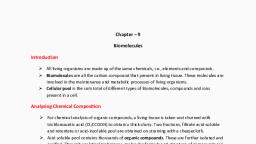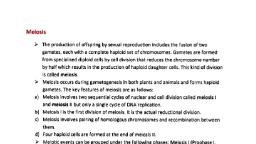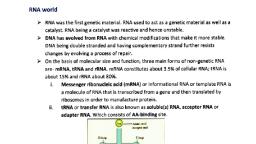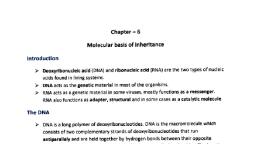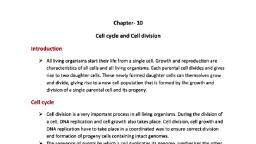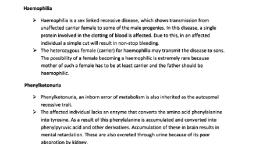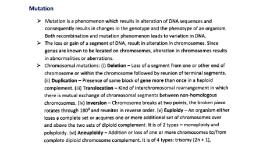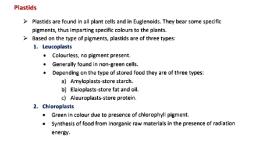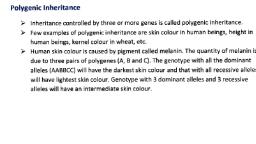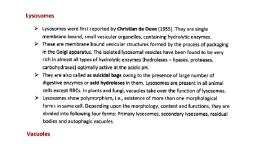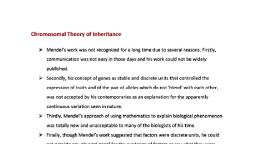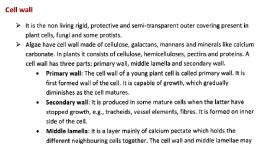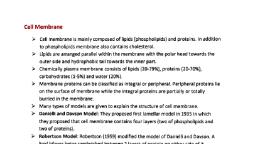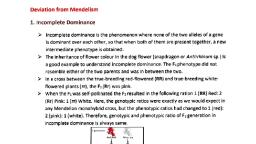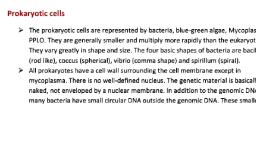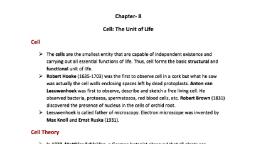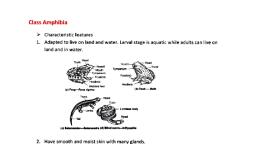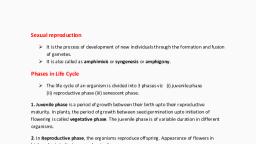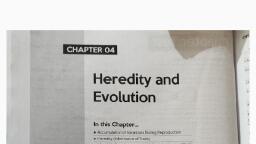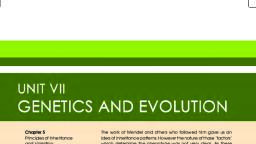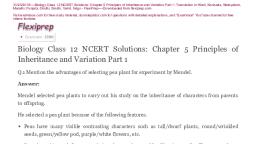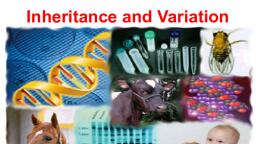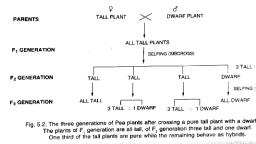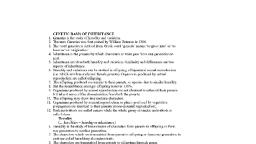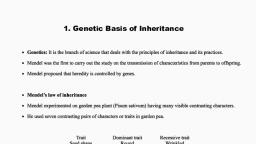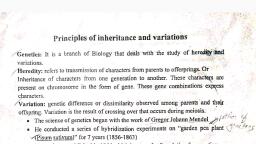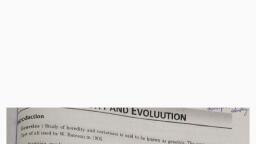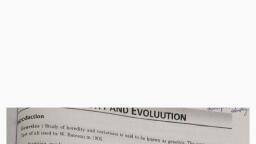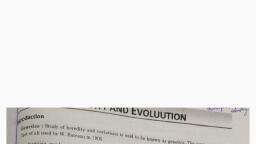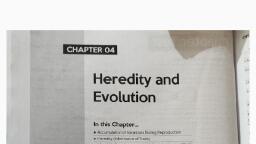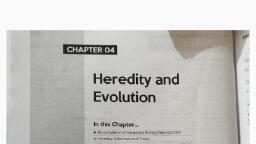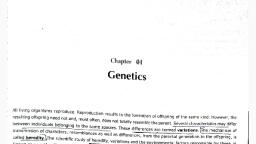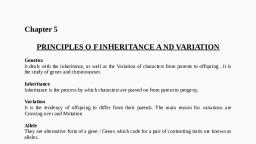Page 1 :
Chapter 5, Principles of Inheritance and Variation, , Introduction, Genetics deals with the inheritance, as well as the variation of characters from, parents to offspring., Inheritance is the process by which characters are passed from the parent to, progeny. It is the basis of heredity. Variation is the degree by which progeny differ, , from their parents., Gregor Johann Mendel: Father of genetics, William Bateson: Gave the term genetics, , Mendel's Laws of Inheritance, Gregor Mendel conducted hybridization experiments on garden peas (Pisum, , sativum) for seven years and proposed the laws of inheritance in living organisms., Mendel investigated characters in the garden pea plant that were manifested as two, opposing traits, e.g, tall or dwarf plants, yellow or green seeds., Mendel conducted such artificial pollination/cross pollination experiments using, , several true-breeding pealines. A true-breeding line is one that having undergone, continuous self-pollination, shows the stable trait inheritance and expression for, several generations. Mendel selected 14 true-breeding pea plant variations, as pairs, which were similar except for one character with contrasting traits., , Table:Characters studied by Mendel, Dominant, Trait studied, Recessive, , 1. Plant height, 2. Flower position, 3. Pod colour, Pod shape, 5. Flower colour, 6. Seed shape, , 7. Seed colour, , Tall(T), , Axillary (A), Green (G) or (Y), , Dwarf(t), Terminal (a), Yellow (g) or (y)_, , Full orinflated ()or (C) Constricted(i) or(c), Violet (V) or (W), , White (v) or (w), , Round (R) or (W), , Wrinkled (r) or (w), , Yellow (Y) or (G), , Green (y) or (g)_, , Reasons for selection of pea plant (Pisum sotivum) as material for experiments:, 1., , Pea plant is annual pant with short life cycle of 2-3 months, , 2., , It has many contrasting trait, , 3., , Natural self pollination is present in pea plant, , 4. Successful cross pollination can be performed in it artificially so hybridization can be, made possible
Page 2 :
5., , Pea plant is easy to cultivate, , 6. Produces large number of seeds., , Inheritance of One Gene, Mendel crossed tall and dwarf pea plants to study the inheritance of one gene., H e collected the seeds produced as a result of this cross and grew them to generate, plants of the first hybrid generation. This generation is called the Filial, progeny or, the F1., , H e observed that all the Fa progeny plants were tall, like one of its parents; none, were dwarf. He made similar observations for the other pairs of traits - he found, , that the Fialways resembled either one of the parents, and that the trait of the, other parent was not seen in them. Mendel then self-pollinated the tal Fi plants and, he found that in the Fageneration some of the offspring were 'tdwarf, the character, , that was not seen in the Figeneration was now expressed., The proportion of plants that were dwarf were 1/4th of the Fa plants while 3/4h of, the Fa plants were tall., The tall and dwarf traits were identical to their parental type and did not show any, , blending, that is all the offspring were either tall or dwarf, none were of in-between, , height., Similar results, , obtained with the other traits that he studied: only, , were, , one, , of the, , parental traits was expressed in the Figeneration while at the Fa stage both the traits, were, , expressed, , in the, , proportion of 3:1. The contrasting traits, , did not show any, , blending at either Fi or Fz stage., , Genetic Terminology, Alleles: These, , slightly, , different forms of the same gene., Homozygous: An organism having identical alleles of factors (or genes) for a, are, , character is called homozygous, e.g, TT, RR, tt., , Heterozygous: An organism having dissimilar alleles of factors (or genes) for a, character is called heterozygous, e.g., Tt, Rr., The, , cross, , between, , character, , (height),, , homozygous tall (TT) and homozygous dwarf (tt) produces, heterozygous tall (Tt) plant. Tt plant is heterozygous for genes controlling one, it is, , a, , monohybrid, , Dominant factor of allele:, whether present in, , (T), , is dominant, , It is, , one, , homozygous, , over, , the, , or, , and this, , of, , a, , pair, , cross is, , called, , of alleles which, , monohybrid, can, , express itself, , heterozygous state, e.g., for height,, , dwarfness gene (t)., , Recessive factor of allele: The factor of an allelic, pair which is unable, effect in the presence of its contrasting factor in a, in, , hybrid tall, , pea, , plant Tt. Recessive factor, , state, e.g, tt in dwarf pea plant., , cross., , Tallness gene, , to express its, , heterozygote, e.g., the allele of 't, is expressed only in the, homozygous
Page 3 :
Phenotype: Itisthe external and morphological appearance of an organism for a, , particularcharacter, Genotype: It is the genetic constitution or genetic make-up of an organism for a, particular character or group of characters., , ro, Geneype ra, PUNNETT SQUARE, , Fig: A Punnett square used to understand a typical monohybrid cross conducted by, Mendel between true-breeding tall plants and true-breeding dwarf plants, The recessive parental trait is expressed without any blending in the Fageneration., , This shows that, when the tall and dwarf plant produce gametes, by the process of, meiosis, the alleles of the parental pair separate or segregate from each other and, only one allele is transmitted to a gamete. This segregation of alleles is a random, process and so there is a 50% chance of a gamete containing either allele. In this way, , the gametes of the tall TT plants have the allele T and the gametes of the dwarf tt, plants have the allele t. During fertilisation the two alleles, T from parent say,, through the pollen, andt from the other parent, then through the egg, are united to, produce zygotes that have one T allele and one t allele. These hybrids contain alleles, which express contrasting traits, the plants are heterozygous., , Punnett Square Method, The production of gametes by the parents, formation of the zygotes, the Fiand Fa, plants can be understood from a diagram called Punnett square developed by a, British geneticist, Reginald C. Punnett.
Page 4 :
I t is a graphical representation to calculate the proba bility of all possible genotypes, of offspring in a genetic cross., , Test cross is a cross between an individual of unknown genotype and recessive, , parent. To determine the genotype of a tall plant at Fz, Mendel crossed the tall plant, from Fa with a dwarf plant. In a typical test cross, an organism showing a dominant, phenotype is crossed with the recessive parent instead of self-crossing. The, , progenies of such a cross can easily be analysed to predict the genotype of the test, organism., , Homorygous, recessive, , Homorygous, recessiv, , Diagrammatic representation of a test eross, , ww, Dominant Phenotype, WwWw, All tlowers are violet, , Unknown flower, Is homorygous dominant, , enotyp unknowr, , Result, , Interpretatlon, , Half of the nowers are violet and, half of the lowers are white., , Unknown lower is heleroyD, , Fig: Diagrammatic representation of a test cross, , Laws of Inheritance, , Laws of dominance, Mendel's postulate of dominance was raised to the status of Law of Dominance by, Correns. The statements are:, , 1. Characters are controlled by discrete units called factors., 2. Factors occur in pairs., 3., , Ina dissimilar pair of factors, one member of the pair dominates the other. In, , a hybrid, dominant allele expresses itself wihile a recessive allele is unable to, , express., , The law of dominance is used to explain the expression of only one ofthe parental, characters in a monohybrid cross in the Fi and the expression of both in the Fz. It also, , explains the proportion of 3:1 obtained at the F2., , Laws of segregation, According to this law, the alleles do not show any blending and that both the, characters are recovered as such in the Fa generation though one of these is not, visible in Figeneration., Though the parents contain two alleles during gamete formation, the factors or, , alleles of a pair segregate from each other such that a gamete receives only one of, the two factors., , Ahomozygous parent produces all sinmilargametes while a heterozygOus one, produces two kinds of gametes each having one allele with equal proportion.

